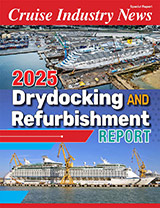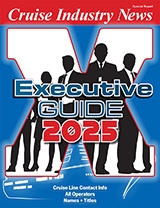 While Carnival Corporation is working to better leverage its scale, according to Josh Leibowitz, chief strategy officer, it is all about guest satisfaction. “Our goal is to exceed guest expectations, while leveraging our scale,” he explained, “and food and beverage play a key role, being the single biggest item of spending after fuel.”
While Carnival Corporation is working to better leverage its scale, according to Josh Leibowitz, chief strategy officer, it is all about guest satisfaction. “Our goal is to exceed guest expectations, while leveraging our scale,” he explained, “and food and beverage play a key role, being the single biggest item of spending after fuel.”
But contrary to fuel, food has what Leibowitz called a high-emotion aspect – involving not only guests, but also chefs and buyers, as well as ship operations and logistics.
Leibowitz talked exclusively to Cruise Industry News in conjunction with a recent unique meeting at Carnival’s corporate headquarters, bringing together 23 purchasing and logistics executives covering all the different brands.
 “We came out of that meeting with a vision statement, a governance model and a road map,” said John Meszaros, vice president of supply chain management with Carnival Corporation. “We identified the first projects we need to get started on.”
“We came out of that meeting with a vision statement, a governance model and a road map,” said John Meszaros, vice president of supply chain management with Carnival Corporation. “We identified the first projects we need to get started on.”
Only weeks after the May meeting, Carnival Australia was already going out with bid invitations on behalf of P&O and the Carnival, Holland America and Princess brands in Australia. Previously the four brands have been purchasing individually for their ships in the Australian market. Prior to the bid, Carnival Australia communicated the change to the vendors that this is the first time they are going out unified and with one point person.
“But it is not just about scale, but also about leveraging our talent,” Leibowitz continued. “Leveraging is much more than about cost benefits, it means using our expertise better, it is about guest satisfaction, and dealing with suppliers in different ways.
“There is a massive human element involved. To work effectively as a group requires patience and trust; we have to cooperate, collaborate and communicate. From a human standpoint, people have to align on a common goal. In our meetings, we have discussed how to work together and how we will succeed.”
He added that Carnival CEO and President Arnold Donald had opened the meeting, encouraging the participants to work together with common goals. According to Donald, the real elevation is ultimately to the guests.
To further illustrate the scope of the effort, Leibowitz said that Carnival as a group spends about $1 billion on food annually, dealing with about 1,000 vendors.
“Our vision is to have a global master plan, integrating where the ships are sailing and sourcing. And acknowledging that some trade-offs may be made to the practical aspects of ship operations and to be economically sustainable. But ultimately it is about elevating the guest experience.
“Our goal is to better align our resources, leverage our scale, work with our culinary teams and to integrate our processes on a global scale. The meeting was the first step in learning how we can work as a single team,” Meszaros said.
He noted that as a corporation, Carnival has organized its brands into groups, with Holland America overseeing Princess, Seabourn and Carnival Australia; Costa covering AIDA and Iberocruceros; and Carnival UK with Cunard and P&O, in addition to the Carnival brand. “This means fewer layers of decision makers, so we can move faster,” Meszaros said.
To help facilitate that process even further, two senior executives have been named as point men for the F&B aspect: Allan Buckelew, COO of Carnival Corporation, for food, and David Dingle, CEO of Carnival UK, for beverages.
“This gives us a single voice for food and beverage, respectively, to the executive team,” Meszaros added.
This may also explain why the Australia bid effort was almost instantaneous.
Reflecting on the meeting, Meszaros said it was refreshing and motivating to hear CEO Arnold Donald say that guest satisfaction is the first priority – not cost, which is what purchasing executives are used to hear. He said his aim is to deliver the best possible product at the lowest cost by leveraging the company’s scale.
“Leveraging scale is not focused on cost,” he added. “Instead it means using our resources and experience better, and our collective knowledge to get better quality.”
Speaking informally, purchasing executives participating in the meeting, seemed energized and optimistic, and said that the discussions were already motivating them to think and approach their tasks differently. “This effort is by itself creating positive energy,” added Leibowitz. “I can see people believing in this and focusing. This is not a project, but a change of culture, a transformational process.”
Excerpt from Cruise Industry News Quarterly Magazine: Summer 2014




